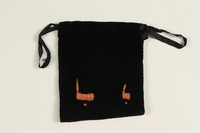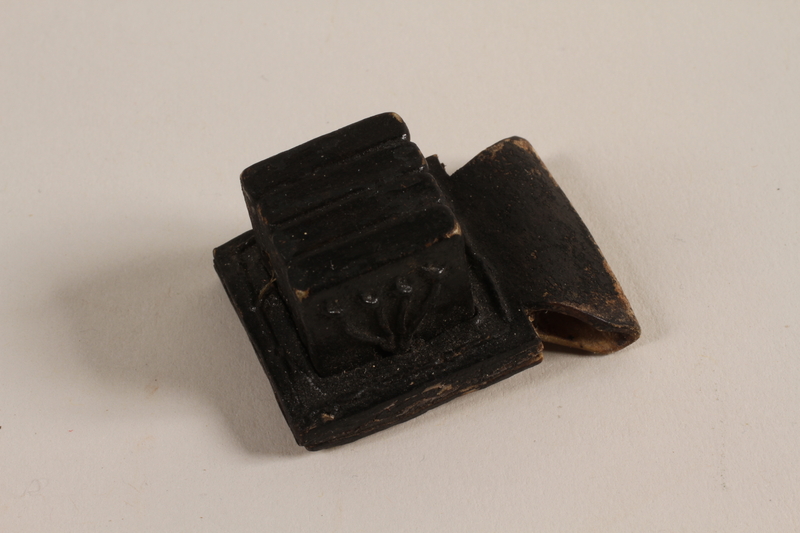Overview
- Brief Narrative
- Two batim from a pair of tefillin used by Bernhard Groeschel. During the Kristallnacht pogrom on November 9-10, 1938, the tefillin were thrown out of the window of his home in Forchheim, Germany. A neighbor saved only the batim and returned them to Bernhard’s wife, Rose, after the war. Tefillin are used by Jewish males during morning prayers. Bernhard was imprisoned in Dachau concentration camp and released in December. In March 1939, Bernhard and Rose sent their 14 year old daughter, Irmgard, on a kindertransport to Basel, Switzerland. After war broke out in September 1939, Bernhard and Rose left Germany for England but were denied entry. They were sent to a refugee camp in the Netherlands and emigrated to the United States in April 1940. Irmgard joined her parents in the United States that August.
- Date
-
use:
before 1938 November 09
recovered: after 1945 May
- Geography
-
use:
Forchheim (Oberfranken, Germany)
recovery: Forchheim (Oberfranken, Germany)
- Credit Line
- United States Holocaust Memorial Museum Collection, Gift of Irma Mathes
- Contributor
-
Subject:
Bernhard Groeschel
Subject: Irma Mathes
- Biography
-
Bernhard Groeschel was born in Forchheim, Germany, on March 12, 1878, to Phillipp and Adelheid Rosenbaum Groeschel. Bernhard had a brother, Gustav, and two sisters, Adelheid and Jenny. In 1924, Bernhard married Rose Goldberg. Rose was born in Emmendingen in 1892 to Olga Goldberg. The couple settled in Forchheim, a primarily Catholic town. Their daughter, Irmgard, was born in 1925. Bernhard managed the family textile business, PH Groeschel, which Phillipp founded. The family lived above the wholesale store and also owned a ready to wear store across the street. They were a prosperous and conservative Jewish family. Bernhard was president of the synagogue.
Following Hitler’s appointment as Chancellor in 1933, Jews were the targets of increasingly severe restrictions and persecution. Anti-Semitic signs were posted outside the family business, urging customers to boycott the stores. During the Kristallnacht pogrom on November 9-10, several townspeople entered the family home and destroyed belongings. Bernhard was deported to Dachau concentration camp. The family doctor, Dr. Greisinger, insisted that Rose was too sick to be interned and she was placed in a hospital. Rose later was sent to a home where all the Jewish women and children were benig held. On December 17, Bernhard was released from Dachau. He was forced to relinquish his business because he was Jewish. As the living conditions for Jews became increasingly dangerous, Bernhard and Rose decided to send Irmgard to Basel, Switzerland, on a kindertransport with the help of the Hebrew Immigrant Aid Society (HIAS). Irmgard moved to Emmendingen with Rose’s mother, Olga, and aunt to establish residency because HIAS only accepted children from the state of Baden. In March 1939, she left for Basel.
After Germany invaded Poland in September 1939, Rose and Bernhard received visas to England. They travelled via ship but British authorities would not accept the refugees. They were sent to the Netherlands, where they were told that the ship would be sent back to Germany. Rose spoke for the other passengers and said that they would commit suicide before going back to Germany. The passengers were then placed in a refugee camp in Rotterdam. Rose’s cousin filed an affidavit of support for her and Bernhard’s immigration to the United States. In April 1940, they traveled on the SS Volendam to New York. Bernhard’s brother, Gustav, had emigrated to the United States in 1938 and provided papers for Irmgard to emigrate to New York in August. Bernhard worked cleaning zippers, and then rented out rooms in the family’s apartment. Rose, age 59, passed away in 1951.
Irmgard Groeschel was born in Erlangen, Germany, on March 24, 1925, to Bernhard and Rose Goldberg Groeschel. Bernhard was born in Forchheim on March 12, 1878, to Phillipp and Adelheid Rosenbaum Groeschel. Rose was born in Emmendingen in 1892 to Olga Goldberg. The family lived in Forchheim, a primarily Catholic town. Bernhard managed the family textile business, PH Groeschel, which Phillipp founded. The family lived above the wholesale store and also owned a ready to wear store across the street. They were a prosperous and conservative Jewish family.
Following Hitler’s appointment as Chancellor in 1933, Jews were the targets of increasingly severe restrictions and persecution. Anti-Semitic signs were posted outside the family business, urging customers to boycott the stores. Irmgard was the only Jewish girl in town and attended a Catholic school where she was gradually discriminated against. She was not allowed to have a bicycle because her parents were afraid she would be thrown off because she was Jewish. Rose and Bernhard gave other parents textiles so their children would play with her, but she was eventually ostracized. By 1935, children would spit at the family when they left synagogue. In 1938, Bernhard and Rose transferred Irmgard to a private Jewish boarding school in Coburg. During the Kristallnacht pogrom on November 9-10, German authorities instructed Irmgard and her fellow students to throw stones at the school’s windows. All of the Jews in Coburg were marched through the town and residents threw stones at them. The Jewish women and children then were locked in a gymnasium for several days. The men were arrested and deported to a concentration camp. After Irmgard and the others were released, the school was closed because the male teachers were interned. Irmgard returned to Forchheim and learned that the Jewish men in the town were imprisoned in Dachau concentration camp and the women and children were staying in one house. On December 17, Bernhard was released from Dachau. He was forced to relinquish his business because he was Jewish. As the living conditions for Jews became increasingly dangerous, Irmgard’s parents decided to send her to Basel, Switzerland, on a kindertransport with the help of the Hebrew Immigrant Aid Society (HIAS). Irmgard moved to Emmendingen with her maternal grandmother, Olga, and aunt to establish residency because HIAS only accepted children from the state of Baden.
Before her departure to Basel in March 1939, Rose told her to throw away her diamond earrings, a present from her paternal aunt, Adelheid, because the German authorities confiscated all valuables. In Basel, Irmgard lived with an Orthodox family, Lena Zucker. The husband sexually assaulted Irmgard, but she did not tell anyone because she feared being sent back to Germany. The Zuckers censored her mail and she would send letters to her parents from the home of a friend of her mother's. After a year, Irmgard was transferred to a female refugee house. She rotated between cleaning, washing laundry and ironing. After Germany invaded Poland in September 1939, Irmgard's parents received visas for Great Britain and left Germany. They were refused entry, and sent to Netherlands and told they would be sent back to Germany. They eventually managed to get US visas and arrived there in April 1940. Bernhard's brother Gustav had emigrated to the United States in 1938 and he filed an affidavit of support for Irmgard's immigration visa to the US. In July 1940, Irmgard received a visa and traveled via bus to Lisbon, Portugal. She sailed on the TSS Nea Hellas to New York and arrived on August 10. She Americanized her name to Irma and graduated from high school in 1943. She attended business college and worked as a legal assistant and a book keeper. In 1948, Irma married Frederick Mathes. Frederick was a German Jew and emigrated to the United States in 1934. The couple had one daughter. Her mother died in 1951. Frederick and Irma divorced in 1977. Irma, age 86, passed away in 2011.
Physical Details
- Language
- Hebrew
- Classification
-
Jewish Art and Symbolism
- Category
-
Jewish ceremonial objects
- Object Type
-
Tefillin (lcsh)
- Physical Description
- a. Head tefillin, a small square box (batim) constructed of 4 black painted leather strips centered on a square, black painted 4 layered leather platform that is sewn together with giddin, gut from kosher animals. The left and right sides of the box have an embossed Hebrew Shin letter; the left Shin has 4 strokes. The platform has a triangular, notched lower end with an opening for a strap to pass through. The platform underside is not painted. The box is to contain 4 separate pieces parchment scrolls inscribed with a Torah verse. Some paint has worn off the edges of the batim and platform.
b. Hand tefillin, a small, square black painted leather box (batim) centered on a square, black painted 4 layered leather platform that is sewn together with giddin, gut from kosher animals. The platform has a triangular, notched lower end with an opening for a strap to pass through. The platform underside is not painted. The box is to contain a parchment scroll inscribed with 4 Torah verses. Some paint has worn off the edges of the batim and platform. - Dimensions
- a: Height: 0.875 inches (2.223 cm) | Width: 1.125 inches (2.858 cm) | Depth: 1.500 inches (3.81 cm)
b: Height: 0.750 inches (1.905 cm) | Width: 1.000 inches (2.54 cm) | Depth: 1.375 inches (3.493 cm) - Materials
- a : leather, paint, gut
b : leather, paint, gut - Inscription
- a. left and right side, left side with 4 strokes, embossed : ש
Rights & Restrictions
- Conditions on Access
- No restrictions on access
- Conditions on Use
- No restrictions on use
Keywords & Subjects
- Topical Term
- Holocaust, Jewish (1939-1945)--Germany--Forchheim--Personal narratives. Jewish children in the Holocaust--Germany--Biography. Jewish refugees--United States--Biography. Jews--Persecutions--Germany--Forchheim--Biography. Kindertransport (Rescue operations)--Netherlands--Personal narratives. Kristallnacht, 1938--Germany--Forchheim--Personal narratives.
Administrative Notes
- Legal Status
- Permanent Collection
- Provenance
- The batim were donated to the United States Holocaust Memorial Museum in 2004 by Irma Mathes, the daughter of Bernhard Groeschel.
- Funding Note
- The cataloging of this artifact has been supported by a grant from the Conference on Jewish Material Claims Against Germany.
- Record last modified:
- 2022-08-30 15:59:50
- This page:
- https://collections.ushmm.org/search/catalog/irn522430
Also in Bernhard Groeschel collection
The collection consists of two batim from a set of tefillin and a tefillin storage pouch relating to the experiences of Bernhard Groeschel in Forchheim, Germany, before and after the Holocaust.
Date: before 1938 November 09-after 1945 May

Black velvet tefillin pouch embroidered BG rescued after Kristallnacht and recovered postwar
Object
Tefillin storage pouch used by Bernhard Groeschel. It is embroidered with his initials. During the Kristallnacht pogrom on November 9-10, 1938, the pouch was thrown out of the window of his home in Forchheim, Germany, near Nuremberg. A neighbor saved the bag and returned it to Bernhard’s wife, Rose, after the war. Tefillin are used by Jewish males during morning prayers. Bernhard was imprisoned in Dachau concentration camp and released in December. In March 1939, Bernhard and Rose sent their 14 year old daughter, Irmgard, on a kindertransport to Basel, Switzerland. After war broke out in September 1939, Bernhard and Rose left Germany for England but were denied entry. They were sent to a refugee camp in the Netherlands and emigrated to the United States in April 1940. Irmgard joined her parents in the United States in August.






